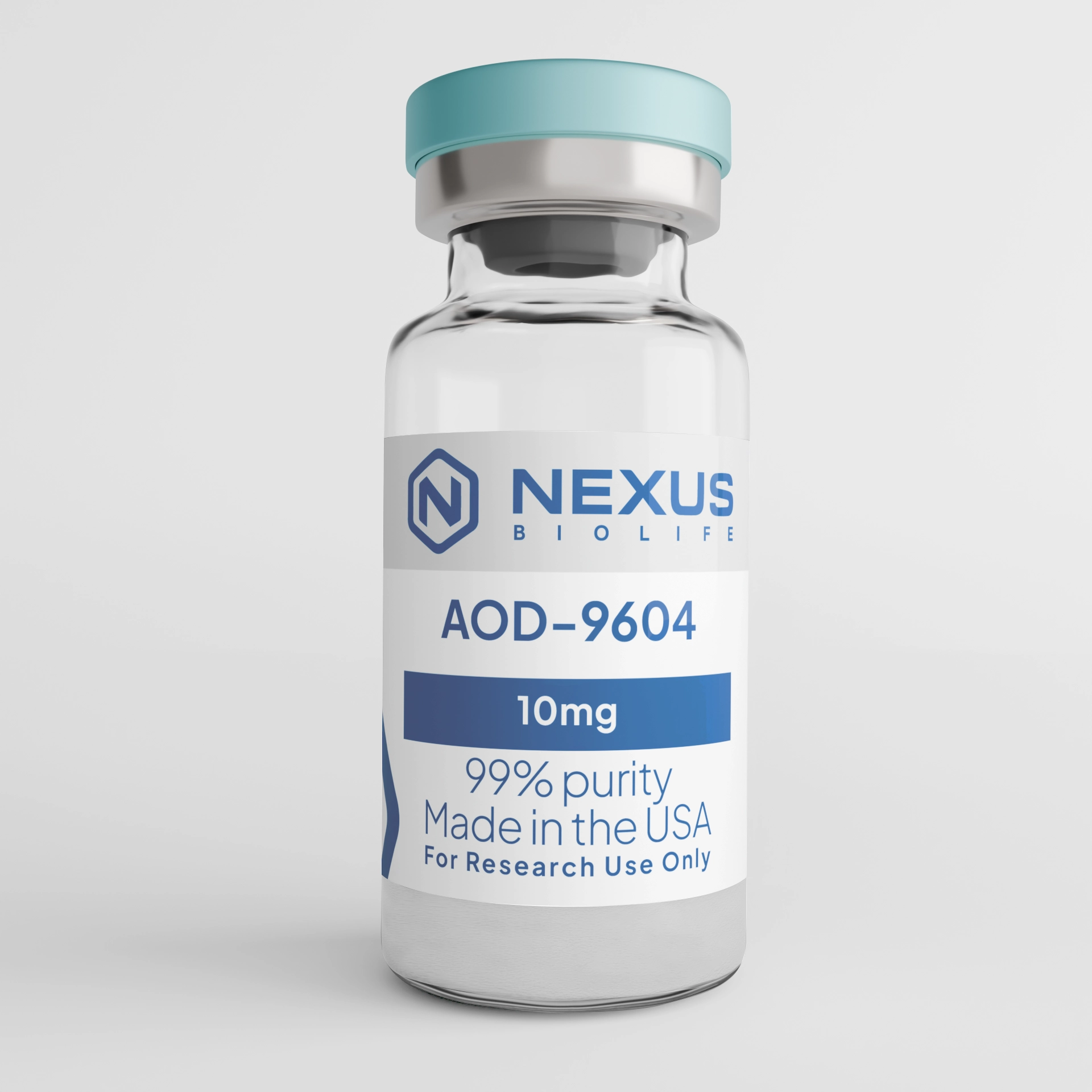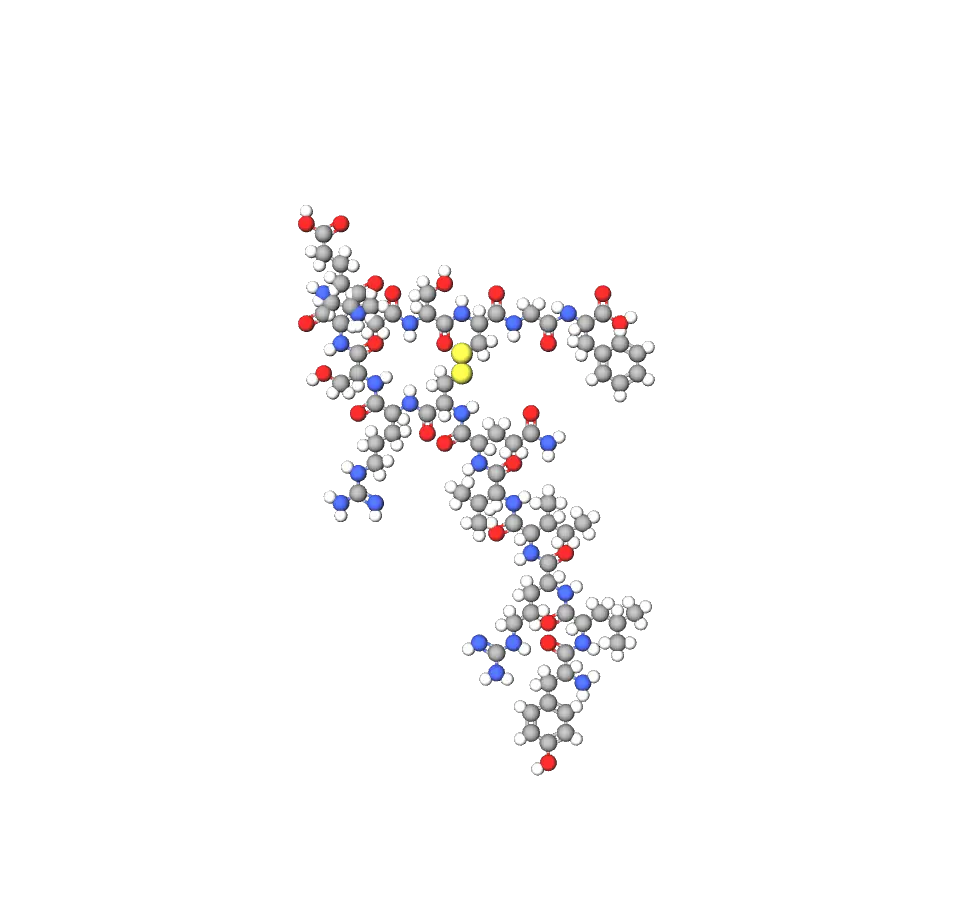
AOD-9604 is a synthetic peptide meticulously designed for scientific inquiry. This product is synthesized with a high purity of 99%. It is utilized in various laboratory investigations. AOD-9604 is designated solely for research and development purposes.

From a structural perspective, AOD-9604 consists of the amino acid sequence Tyr-Leu-Arg-Ile-Val-Gln-Cys-Arg-Ser-Val-Glu-Gly-Ser-Cys-Gly-Phe, featuring a cyclic disulfide bond between the cysteine residues at positions 7 and 14 for enhanced stability. Its molecular formula is C78H123N23O23S2, with a molecular weight of approximately 1815 Da. This peptide is notable for its oral bioavailability in animal models, unlike full hGH, and it exhibits rapid degradation in plasma through N-terminal truncation, with a half-life of around 4 minutes in vitro. In research settings, it's stable in lyophilized form and soluble in aqueous buffers, making it suitable for in-vitro experiments on adipocytes or cartilage cells. We approach these details with a steady rationale: understanding the structure helps optimize experimental designs, but always remember, our peptides are for research purposes only.
At our company, we're all about making peptide science approachable and reliable for researchers like you. AOD-9604, a synthetic analog of the C-terminal fragment of human growth hormone (hGH), is a 16-amino acid peptide designed to mimic specific metabolic effects without the full range of hGH activities. Specifically, it's derived from amino acids 177-191 of hGH with an added tyrosine at the N-terminus, and it's often studied for its potential in lipid metabolism and tissue repair models. In research contexts, AOD-9604 is explored for its lipolytic properties—promoting fat breakdown in cellular assays—while emphasizing in-vitro use only, with no implications for human consumption or therapeutic applications. Think of it as a targeted tool for investigating obesity-related pathways, simple yet precise in its biochemical focus.
Delving into its origins, AOD-9604 was developed in the 1990s by researchers at Monash University in Australia, aiming to isolate the lipolytic domain of hGH for potential anti-obesity studies. Early work identified the C-terminal region of hGH as key to fat metabolism, leading to the synthesis of fragments like AOD-9401 and eventually AOD-9604, which incorporated modifications for stability. Over time, preclinical investigations in animal models, such as obese Zucker rats, demonstrated its ability to reduce body weight gain without affecting insulin sensitivity, building a foundation for further metabolic research. We're enthusiastic about these foundational insights because they underscore the value of evidence-based exploration—straightforward science that empowers researchers to test hypotheses without the noise of unsubstantiated claims.
To sum it up, AOD-9604 exemplifies the targeted ingenuity of peptide design—a compact fragment with significant potential in metabolic and regenerative research. As your dependable partner in peptide research, we're thrilled to offer such tools to advance your work, always rooted in solid evidence and shared with a warm, collaborative spirit. Whether probing fat metabolism or tissue repair mechanisms, AOD-9604 provides a solid foundation for innovation. Together, let's continue unraveling the intricacies of science, one study at a time.
Researchers often utilize AOD-9604 in areas like obesity modeling, where it's tested in cellular assays to study lipolysis in adipocytes or in animal models for weight management effects. It's also applied in regenerative research, such as intra-articular injections in rabbit osteoarthritis models to assess cartilage regeneration, often combined with hyaluronic acid for synergistic outcomes. In cancer-related studies, it has been explored for enhancing the toxicity of chemotherapeutics like doxorubicin in breast cancer cell lines when loaded into nanoparticles. We verify our AOD-9604 through HPLC and mass spectrometry for high purity, fostering trust in your results.
On the practical side: Store lyophilized at -20°C, reconstitute in sterile water or buffer for in-vitro applications. Typical research concentrations range from 250 µg/kg in animal models to micromolar levels in cell cultures, but tailor to your specific protocol. Importantly, this peptide is strictly for laboratory research—not for diagnostic, therapeutic, or human use. We're committed to supporting your inquiries with quality and ethics at the forefront.
Scientifically, AOD-9604 has been associated with selective lipolytic effects in experimental models, stimulating the breakdown of fats in adipose tissue while inhibiting new fat formation. Studies in obese mice and rats show it reduces body weight gain by over 50% in some cases, increasing fat oxidation via upregulation of beta-3 adrenergic receptors without impacting growth or IGF-1 levels. Unlike full hGH, it avoids diabetogenic side effects, maintaining insulin sensitivity in chronic treatments. Beyond metabolism, research suggests regenerative potential, such as enhancing cartilage repair in osteoarthritis models by promoting proteoglycan and collagen synthesis in chondrocytes. It may also support bone regeneration by influencing osteoblast activity and could play a role in muscle cell differentiation. Our perspective? These activities make AOD-9604 a valuable probe for dissecting metabolic and reparative pathways, grounded in controlled, rigorous studies.
At our company, we're all about making peptide science approachable and reliable for researchers like you. AOD-9604, a synthetic analog of the C-terminal fragment of human growth hormone (hGH), is a 16-amino acid peptide designed to mimic specific metabolic effects without the full range of hGH activities. Specifically, it's derived from amino acids 177-191 of hGH with an added tyrosine at the N-terminus, and it's often studied for its potential in lipid metabolism and tissue repair models. In research contexts, AOD-9604 is explored for its lipolytic properties—promoting fat breakdown in cellular assays—while emphasizing in-vitro use only, with no implications for human consumption or therapeutic applications. Think of it as a targeted tool for investigating obesity-related pathways, simple yet precise in its biochemical focus.
Delving into its origins, AOD-9604 was developed in the 1990s by researchers at Monash University in Australia, aiming to isolate the lipolytic domain of hGH for potential anti-obesity studies. Early work identified the C-terminal region of hGH as key to fat metabolism, leading to the synthesis of fragments like AOD-9401 and eventually AOD-9604, which incorporated modifications for stability. Over time, preclinical investigations in animal models, such as obese Zucker rats, demonstrated its ability to reduce body weight gain without affecting insulin sensitivity, building a foundation for further metabolic research. We're enthusiastic about these foundational insights because they underscore the value of evidence-based exploration—straightforward science that empowers researchers to test hypotheses without the noise of unsubstantiated claims.
To sum it up, AOD-9604 exemplifies the targeted ingenuity of peptide design—a compact fragment with significant potential in metabolic and regenerative research. As your dependable partner in peptide research, we're thrilled to offer such tools to advance your work, always rooted in solid evidence and shared with a warm, collaborative spirit. Whether probing fat metabolism or tissue repair mechanisms, AOD-9604 provides a solid foundation for innovation. Together, let's continue unraveling the intricacies of science, one study at a time.
From a structural perspective, AOD-9604 consists of the amino acid sequence Tyr-Leu-Arg-Ile-Val-Gln-Cys-Arg-Ser-Val-Glu-Gly-Ser-Cys-Gly-Phe, featuring a cyclic disulfide bond between the cysteine residues at positions 7 and 14 for enhanced stability. Its molecular formula is C78H123N23O23S2, with a molecular weight of approximately 1815 Da. This peptide is notable for its oral bioavailability in animal models, unlike full hGH, and it exhibits rapid degradation in plasma through N-terminal truncation, with a half-life of around 4 minutes in vitro. In research settings, it's stable in lyophilized form and soluble in aqueous buffers, making it suitable for in-vitro experiments on adipocytes or cartilage cells. We approach these details with a steady rationale: understanding the structure helps optimize experimental designs, but always remember, our peptides are for research purposes only.

Researchers often utilize AOD-9604 in areas like obesity modeling, where it's tested in cellular assays to study lipolysis in adipocytes or in animal models for weight management effects. It's also applied in regenerative research, such as intra-articular injections in rabbit osteoarthritis models to assess cartilage regeneration, often combined with hyaluronic acid for synergistic outcomes. In cancer-related studies, it has been explored for enhancing the toxicity of chemotherapeutics like doxorubicin in breast cancer cell lines when loaded into nanoparticles. We verify our AOD-9604 through HPLC and mass spectrometry for high purity, fostering trust in your results.
On the practical side: Store lyophilized at -20°C, reconstitute in sterile water or buffer for in-vitro applications. Typical research concentrations range from 250 µg/kg in animal models to micromolar levels in cell cultures, but tailor to your specific protocol. Importantly, this peptide is strictly for laboratory research—not for diagnostic, therapeutic, or human use. We're committed to supporting your inquiries with quality and ethics at the forefront.
Scientifically, AOD-9604 has been associated with selective lipolytic effects in experimental models, stimulating the breakdown of fats in adipose tissue while inhibiting new fat formation. Studies in obese mice and rats show it reduces body weight gain by over 50% in some cases, increasing fat oxidation via upregulation of beta-3 adrenergic receptors without impacting growth or IGF-1 levels. Unlike full hGH, it avoids diabetogenic side effects, maintaining insulin sensitivity in chronic treatments. Beyond metabolism, research suggests regenerative potential, such as enhancing cartilage repair in osteoarthritis models by promoting proteoglycan and collagen synthesis in chondrocytes. It may also support bone regeneration by influencing osteoblast activity and could play a role in muscle cell differentiation. Our perspective? These activities make AOD-9604 a valuable probe for dissecting metabolic and reparative pathways, grounded in controlled, rigorous studies.
